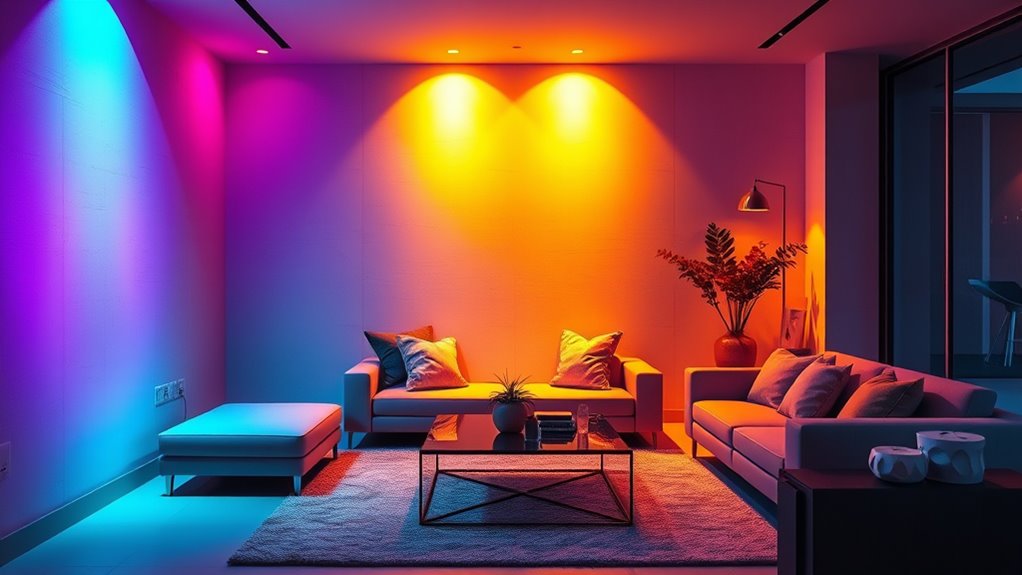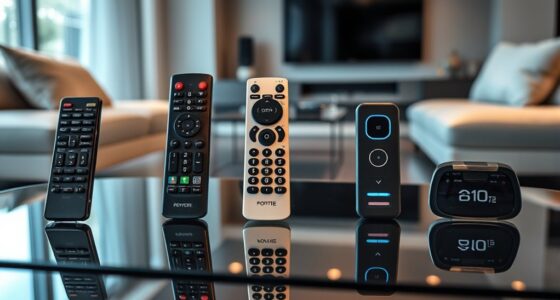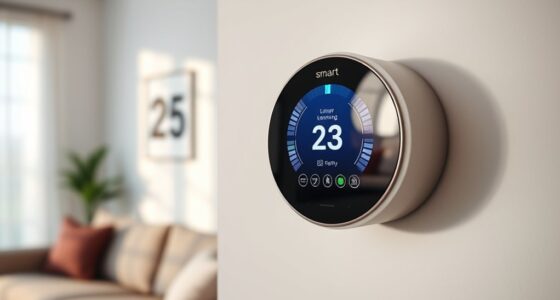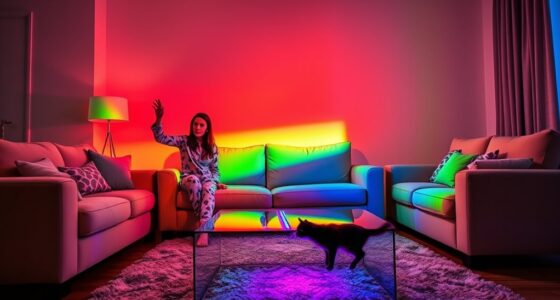The future of smart lighting will see color-changing tech become even more personalized and responsive, blending advanced LEDs, sensors, and AI to perfectly match your mood and activities. Expect seamless control via voice, apps, or automation, with dynamic scenes that adjust brightness and hue throughout your day. Energy efficiency and health-focused features will also improve, creating a more immersive and sustainable environment. Keep exploring to discover how these innovations will transform your space in exciting ways.
Key Takeaways
- Advancements in LED and sensor technology enable highly customizable, immersive color-changing lighting for personalized atmospheres.
- Integration of wireless standards like Wi-Fi 6E and Bluetooth 5.0 ensures faster, more reliable, and seamless control of smart lights.
- AI-driven automation and adaptive scenes optimize mood, energy efficiency, and well-being through real-time environmental analysis.
- Standardized protocols like Matter improve interoperability across platforms, fostering a unified ecosystem for color-changing smart lighting.
- Future trends focus on human-centric lighting that supports circadian rhythms, health, and sustainability through dynamic color temperature adjustments.
The Evolution of Smart Lighting and Its Technological Foundations
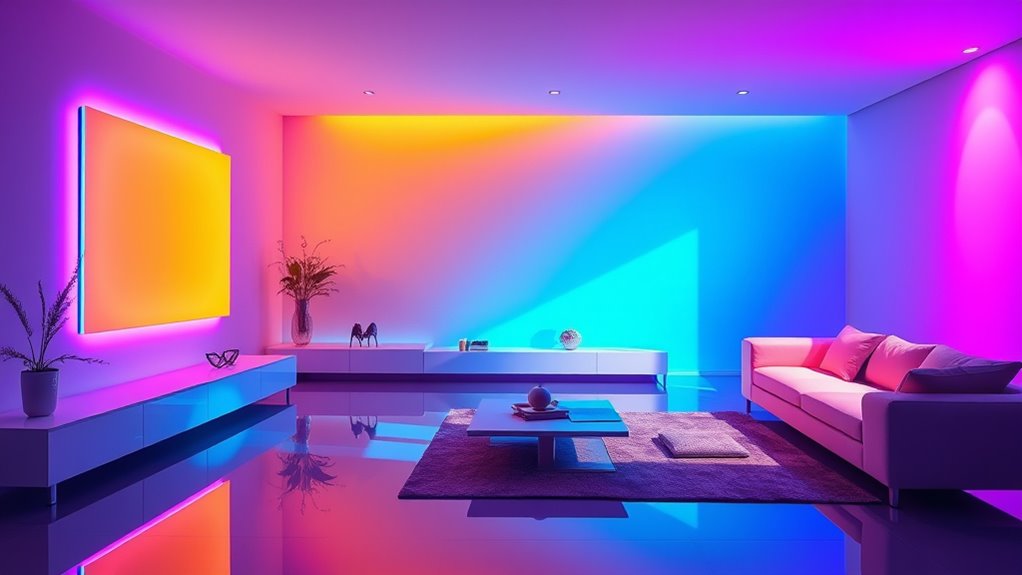
The evolution of smart lighting has been driven by key technological advancements that transformed traditional bulbs into intelligent, connected systems. Initially, digital systems like X10 in the 1980s used power line signals but faced reliability issues. The introduction of protocols like Z-Wave in 2005 improved wireless communication, making smart lighting more dependable. When Philips Hue launched in 2012, it revolutionized the market by enabling smartphone control of LED bulbs, making smart lighting accessible and easy to use. Advances in LED technology, such as higher efficiency, longer lifespan, and better color rendering, played a crucial role in this evolution. Today’s lighting systems integrate sensors, microprocessors, and wireless standards, turning simple bulbs into intelligent lighting environments that adapt to your needs. Additionally, juice cleansing and detox methods showcase how dietary choices can influence overall health, emphasizing the importance of integrating beneficial habits into daily routines. The development of color-changing technology has further expanded the capabilities of smart lighting, allowing users to customize ambiance and functionality effortlessly, and the integration of dimmable features has enhanced energy efficiency and mood setting options. Moreover, incorporating lifestyle-focused features like remote control and automation has made smart lighting an integral part of modern home design.
How Color-Changing Lights Enhance Personalization and Ambiance

Color-changing lights transform your living space by offering a vast palette of up to 16 million colors, giving you the power to personalize your environment precisely to your mood or occasion. With support for preset scenes and dynamic progressions, they can mimic natural lighting or energize a party. Advanced lighting technology enables these bulbs to automatically adjust hue and brightness based on time, activity, or your preferences via automation, enhancing personalization. This flexibility allows you to craft the perfect ambiance, whether relaxing with warm tones or creating vibrant settings for social gatherings. Integration with your smart home system means remote control and scheduling are effortless, making your lighting truly adaptive to your daily routine. Additionally, some systems incorporate Culinary Experiences features that can synchronize lighting with your entertainment or dining setup, elevating your overall environment.
Integrating Sensors and AI for Adaptive and Responsive Lighting
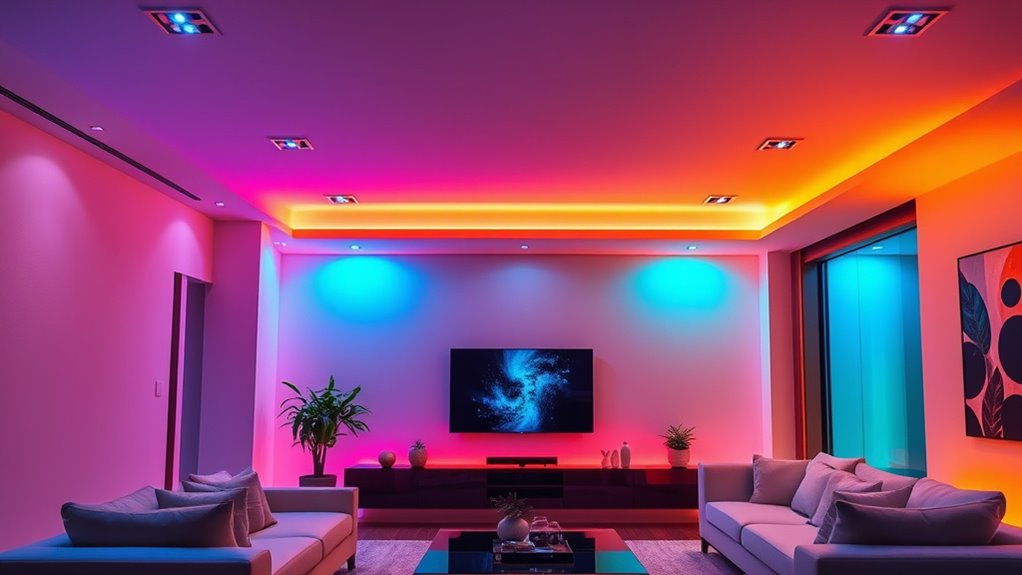
By integrating sensors and AI, smart lighting systems can automatically respond to your environment and activities, creating a more comfortable and efficient space. Sensors detect ambient light, motion, and occupancy, allowing the system to adjust brightness and color temperature for ideal comfort. AI analyzes this data in real-time to develop adaptive lighting scenes that respond dynamically to environmental changes and your activity patterns. This integration enables features like circadian rhythm lighting, which gradually shifts color and intensity to support better sleep and alertness. Regular maintenance of these systems ensures their continued accuracy and responsiveness, preventing issues like sensor malfunctions or calibration drift. Advanced sensors can even identify specific behaviors or preferences, enabling personalized lighting settings based on the time of day or activity. Additionally, understanding user preferences helps optimize the lighting experience further, making it more intuitive and tailored to individual needs. Incorporating smart technology enhances energy savings while delivering a responsive, tailored lighting experience that adapts seamlessly to your needs. Proper calibration and updates are essential to maintain system accuracy and security, ensuring the system remains reliable and up-to-date. Furthermore, ongoing system updates can improve functionality and security, ensuring the system remains reliable and up-to-date.
Connectivity Options and Control Methods for Future-Ready Systems

Future smart lighting systems will rely on a variety of connectivity options and control methods to deliver a seamless user experience. Wi-Fi 6 and Wi-Fi 6E will enable faster, more reliable connections, enhancing integration with other smart home devices. Bluetooth 5.0 offers low-latency, direct control for localized lighting without needing internet access. Control methods will expand to include voice commands through AI assistants like Alexa, Google Assistant, and Siri, allowing hands-free operation. The adoption of the matter protocol will guarantee interoperability across different platforms and devices, simplifying setup and management. Smartphone apps will become more intuitive, providing customizable scenes, scheduling, and remote control options. Additionally, advancements in smart home automation will allow lighting systems to adapt dynamically to user preferences and daily routines. As security and privacy considerations become more prominent, future systems will incorporate privacy policies and user consent options to protect user data. Moreover, understanding the evolving landscape of AI bifurcation will help developers design smarter, more adaptive lighting solutions that align with societal needs. Incorporating AI security principles will be essential to safeguard these intelligent systems from cyber threats and ensure user trust. The increasing availability of regional resources can further support users in customizing and troubleshooting their setups. These advancements will make future smart lighting systems more versatile, user-friendly, and responsive to your needs.
Automations and Scenes: Creating Dynamic and Mood-Driven Environments

You can easily set up lighting scenes that match your mood or activity, whether it’s relaxing, partying, or watching a movie. Advanced bulbs offer millions of colors and smooth shifts, making each environment feel unique. Automations triggered by schedules, voice commands, or sensors let your lights adapt seamlessly throughout the day. Incorporating smart diffusers into your setup can also enhance the ambiance by adding personalized aromatherapy experiences that complement your lighting schemes. Additionally, integrating organized zones ensures your lighting transitions are smooth and tailored to specific areas or activities, which can improve overall well-being by creating calming or energizing environments. Utilizing AI-powered scene creation can further optimize your lighting settings by analyzing your habits and automatically adjusting to suit your lifestyle. Using aesthetic wall organization can further enhance your space by maintaining a clutter-free and visually appealing environment, supporting your mood and comfort.
Customizing Lighting Scenes
Have you ever wished your lighting could automatically adapt to your mood or activity? With customizable lighting scenes, you can preset specific colors, brightness levels, and effects for different occasions, like relaxing evenings or lively parties. Many smart bulbs support dozens or even hundreds of scenes, making it easy to transform your environment instantly. You can create immersive ambiances by adding effects like color shifts, strobe, or gradual dimming. Scene control integrates seamlessly with voice assistants and smartphone apps, letting you activate or tweak settings with a tap or command. This level of customization enhances your smart home experience, allowing you to craft the perfect atmosphere effortlessly and enjoy a truly personalized lighting environment.
Automating for Mood
Automations and scenes take personalized lighting a step further by enabling your smart bulbs to adapt automatically to your routines, moods, or activities. With automations, you can preset dynamic lighting changes that activate based on schedules, events, or sensor triggers, creating mood-specific environments. For example, a “Relax” scene might gradually shift the lighting from warm white to soft pink, enhancing a calming atmosphere. Smart bulbs support hundreds of preset scenes, like “Party” or “Movie Night,” which can be triggered manually or via automation routines. Automations can also utilize geofencing, adjusting colors and brightness when you arrive home. Understanding the underlying neuroscience of dreaming can inspire innovative ways to synchronize lighting with subconscious cues, creating truly immersive environments. Key benefits include:
- Seamless mood transitions
- Personalized experiences
- Effortless adaptation to daily routines
- Turning Dreams into Achievable Goals can help you plan and refine your automation settings for optimal comfort and ambiance.
Energy Efficiency and Sustainability in Advanced Smart Lighting
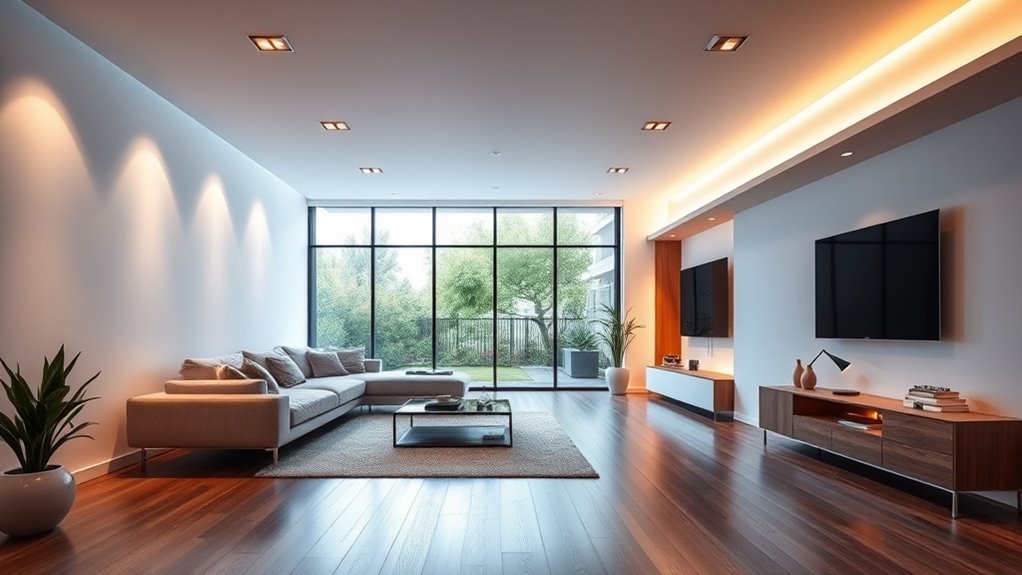
How does advanced smart lighting enhance energy efficiency and support sustainability? It leverages LED lighting, which offers high energy efficiency and long lifespans exceeding 20,000 hours, reducing waste and replacement costs. Smart lighting systems use automation and sensors to turn off or dim lights when not needed, cutting unnecessary energy consumption. Features like scheduling, daylight harvesting, and circadian rhythm adjustments optimize energy use throughout the day, aligning lighting with natural patterns. Standardized protocols like Matter improve interoperability, making it easier to integrate smart lighting with renewable energy sources and smart grids. Color-changing tech enables dynamic scenes that promote well-being while precisely controlling brightness and temperature, further minimizing energy waste. Together, these innovations make smart lighting a sustainable choice for the future.
Emerging Trends: Human-Centric, Health-Focused, and Sustainable Lighting

Emerging trends in smart lighting focus on making illumination more human-centric, health-focused, and sustainable. You benefit from lighting that adapts to your circadian rhythm by automatically adjusting color temperature and brightness, promoting better sleep and alertness. Health-focused smart lighting includes features like UV and blue light regulation, reducing eye strain and supporting your body’s natural processes. Sustainable lighting emphasizes long-lasting LEDs with lifespans exceeding 20,000 hours, which minimizes waste and energy use. Look for these innovations:
- AI-driven personalization that responds to your activity and mood
- Interoperable systems using standards like the Matter protocol
- Dynamic adjustments of color temperature for prime well-being
These trends ensure your environment promotes health, comfort, and sustainability through smarter lighting solutions.
Real-World Applications and Innovations in Residential and Commercial Spaces
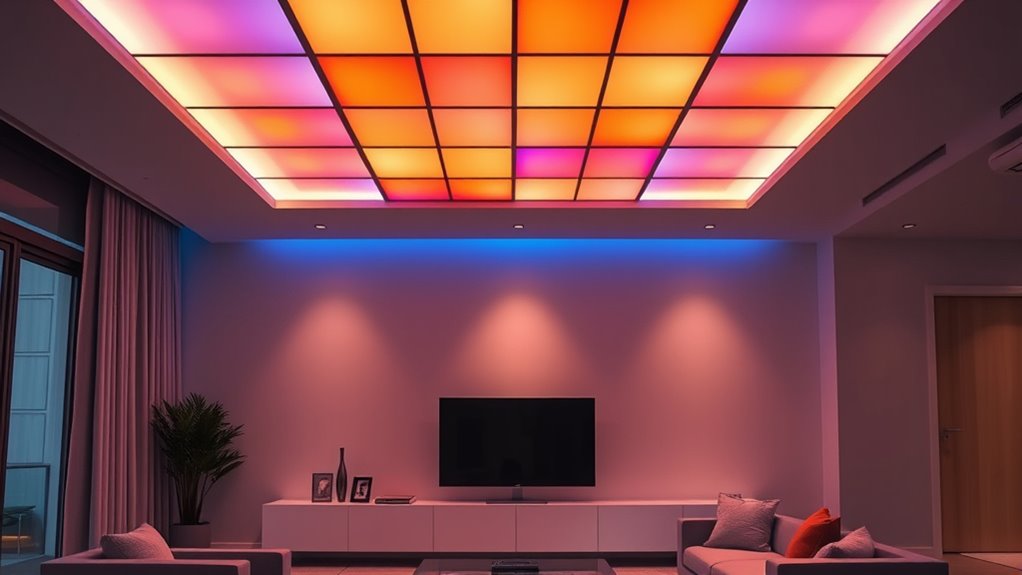
Smart lighting is transforming both homes and commercial spaces by offering customizable, dynamic environments that enhance comfort, productivity, and ambiance. Color-changing lighting in smart homes allows you to set mood-specific scenes, relax, or energize with millions of colors and remote scheduling. In commercial lighting, businesses leverage color-adjustable solutions to influence customer behavior, boost employee efficiency, and reinforce branding through adaptive scenes. Innovations like circadian rhythm lighting promote health and well-being, while also improving energy efficiency. Large-scale projects, such as Dubai’s smart city, utilize thousands of color-changing streetlights to improve safety and reduce energy consumption. Advanced lighting control protocols like the Matter standard enable seamless integration across devices, creating more flexible, immersive environments in both residential and commercial applications.
Challenges, Security Considerations, and the Road Ahead for Color-Changing Smart Lighting
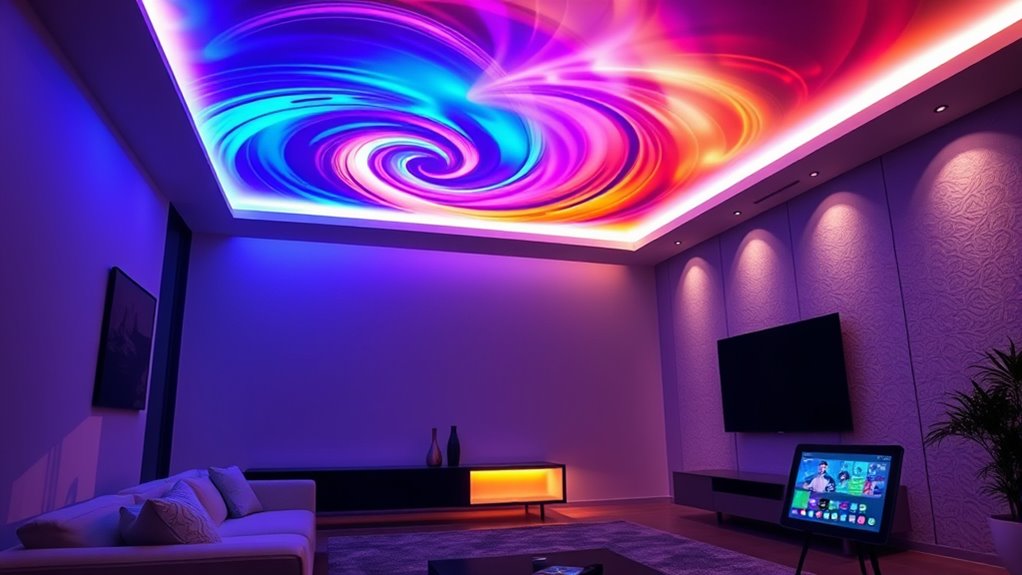
As color-changing smart lighting systems become more widespread, security concerns and compatibility issues pose significant challenges. You must protect your network from vulnerabilities like default passwords, outdated firmware, and hacking risks that threaten your privacy. Compatibility problems stem from diverse protocols such as Wi-Fi, Zigbee, and Bluetooth, complicating integration and increasing cybersecurity risks. To address these issues, implementing strong encryption, regular firmware updates, and multi-factor authentication is essential. The industry is moving toward standardization with protocols like Matter, which aims to improve security and interoperability across brands. Future advancements will likely include AI-driven security features, enhanced encryption methods, and more user-friendly ecosystems, ensuring smarter, safer lighting while overcoming current hurdles.
Frequently Asked Questions
What Is the Future of Smart Lighting?
You’re wondering about the future of smart lighting, and it’s exciting! You’ll see more human-centric, color-changing lights that adapt to your circadian rhythms, improving your health and mood. Devices will seamlessly work together using standards like Matter, while AI and sensors personalize your lighting based on your preferences and environment. Plus, smarter, energy-efficient lights will last longer, offering tailored experiences through features like facial recognition and mood detection, making your space more responsive than ever.
What Technology Will Replace LED Lights?
You’re wondering what technology will replace LED lights. Right now, quantum dots are leading due to their better color accuracy and energy efficiency. MicroLEDs promise brighter, more durable solutions, while OLEDs offer flexible, diffuse illumination. Laser-based systems could surpass LEDs in intensity and longevity for industrial use. Additionally, tunable nanomaterials aim to create eco-friendly, customizable lighting, potentially transforming how you light your space in the future.
What Is the Future of the Lighting Industry?
You’re wondering about the future of the lighting industry, and it’s headed toward smarter, more personalized solutions. Expect human-centric lighting that adapts to your circadian rhythms, with seamless device integration thanks to standards like Matter 1.0. Energy-efficient LEDs with long lifespans, AI-driven automation, and facial recognition will create highly tailored, sustainable lighting experiences that improve your well-being and reduce environmental impact.
What Is the New Lighting Technology?
You’re exploring new lighting technology that combines advanced LED systems with millions of color options, allowing dynamic, customizable effects. These systems support smart home integration through protocols like Matter, offering seamless connectivity via Wi-Fi, Bluetooth, and mesh networks. They often include AI-driven automation, adaptive color schemes based on your preferences, and circadian rhythm features. Plus, they focus on energy efficiency, long-lasting bulbs, and easy control through apps, voice commands, or automation.
Conclusion
As you embrace these advancements, imagine walking into your home where colors shift effortlessly to match your mood, all while conserving energy. Some might worry about complexity or security, but with intuitive controls and robust protections, smart lighting becomes seamlessly integrated into your life. The future promises vibrant, personalized environments that enhance comfort and well-being—making every space not just smarter, but truly alive with your unique style and needs.
